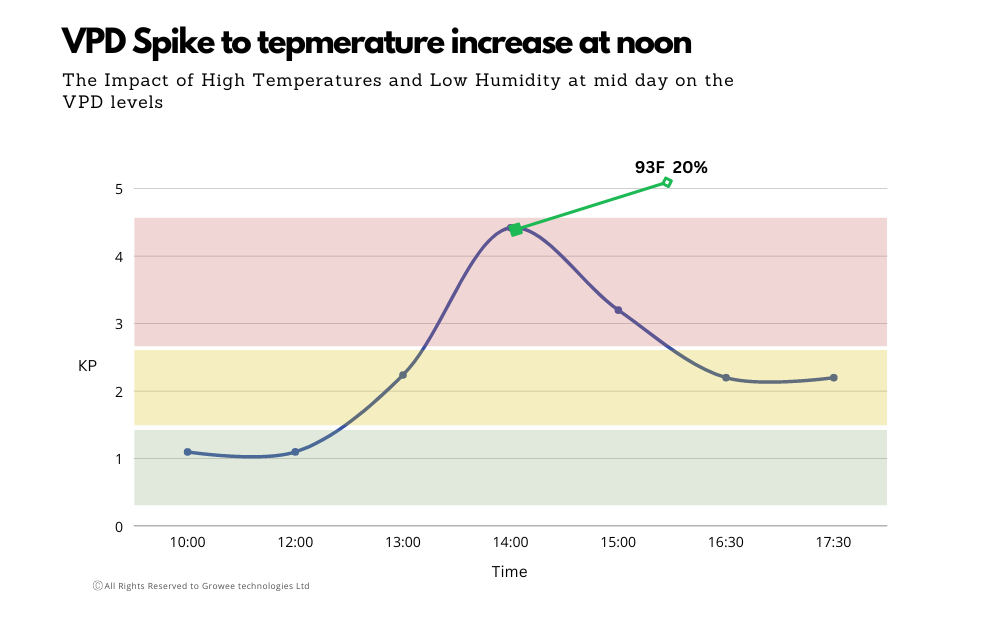Plants are a lot like people – they need the right balance of temperature and humidity to thrive. But while humans have the luxury of turning up the heat or running the air conditioner to find our sweet spot, plants have to rely on us to create the perfect environment for them. That’s where Vapor Pressure Deficit (VPD) comes in.
VPD is a measure of the difference between the amount of water vapor that is present in the air and the amount that the air can hold at a specific temperature. It’s kind of like the tension between a plant and its surroundings, and it can have a big impact on a plant’s growth and development.
In this article, we’ll delve into the world of VPD and explore why it’s so important for plants. We’ll also look at how to manage VPD in your own hydroponic system, so you can give your plants the best chance at success. So let’s dive in!
See How Growee Can Save You Time By Automating Your Plants Feeding
Water pH – Automated pH Up and Down Control
Nutrients Mixing – Automated Nutrient Dosing with Target EC / PPM Control.
Control From Anywhere – WiFi Connection and mobile App
What is VPD, Exactly?
It’s a measure of the difference between the amount of water vapor that is present in the air and the amount that the air can hold at a specific temperature. It’s typically expressed in units of pressure, like pascals or kilopascals, and it’s calculated by subtracting the vapor pressure of the air from the saturated vapor pressure at a given temperature.

So, Why is VPD so Important?
It’s all about the rate at which water evaporates from a plant’s leaves. This process, called transpiration, helps plants regulate their temperature and absorb nutrients from the soil. But if the VPD is too high, it can cause plants to become stressed, leading to reduced growth and yield. On the flip side, if the VPD is too low {indicating the air is near saturation} plants can become oversaturated with water, leading to problems like root rot. High VPD can also increase the risk of diseases and pests, and reduce nutrient uptake.
And What Will Happen if the VPD is Too High?
Well, plants may experience a decrease in photosynthesis and transpiration, leading to reduced growth and yield. High VPD can also lead to increased risk of diseases and pests, as well as reduced nutrient uptake. Plants subjected to high VPD for extended periods of time may become wilted or show signs of stress, like yellowing leaves or stunted growth. In extreme cases, high VPD can even cause plants to kick the bucket.
There are various online VPD calculators that are easily accessable by inputting measurements taken in the grow area by hand, also there are instruments that can calculate and keep an eye automatically.

So How Does VPD Work?
It all comes down to temperature and humidity. The warmer the air, the more water vapor it can hold. The more humid the air, the less room there is for additional water vapor. When the air is dry and warm, the VPD will be high. When the air is cool and humid, the VPD will be low. In general, plants prefer a moderate VPD, but different plants have different preferences, so it’s important to understand the specific needs of the plants being grown.
Keeping your plants happy and healthy isn’t rocket science – it just takes a little bit of understanding of Vapor Pressure Deficit (VPD). If you’re looking to raise the VPD, there are a few tricks you can try: turn up the heat or turn on the dehumidifier. On the other hand, if you want to lower the VPD, turn on the air conditioning or the humidifier.
But before you start fiddling with the thermostat, it’s important to understand that different plants have different VPD preferences. Some plants like it hot and dry, while others prefer a more moderate climate. To find the sweet spot for your plants, it’s best to do a bit of research and figure out what they need.
So don’t let your plants wilt or drown – keep an eye on the VPD and give them the perfect balance of temperature and humidity. They’ll thank you for it!
How to calculate VPD?
When it comes to calculating your vapor pressure deficit (VPD), it’s important to use a simple formula, that is why we recommend usign the full VPD formula, if you measure your temperature in Fahrenheit, you’ll have to convert it to Celsius using the following formula: C°=59(F-32).
Full VPD formula, where T represents temperature and RH represents humidity:
VPD = 0.611e(17.5T)/(T+240.97)(1-RH)
Here’s an example of how to use the VPD formula:
let’s say you’ve got a temperature of 68 degrees Fahrenheit and humidity at 80%.
First thing we need to do is to conver the 68 degrees Fahrenheit to degrees Celsius using the formula above. 68 degrees Fahrenheit = 20 degrees Celsius.
Now we can use the VPD formula ,where T = 20 and RH = 80.
VPD = 0.611e(17.520)/(20+240.97)(1-80)= 0.48 kPa
Keep in mind, this is just an approximation, as actual atmospheric pressure, temperature, and humidity can vary. But, it’s a good starting point to monitor and control the conditions for your plants.
Keeping your plants happy and healthy isn’t rocket science – it just takes a little bit of understanding of Vapor Pressure Deficit (VPD). If you’re looking to raise the VPD, there are a few tricks you can try: turn up the heat or turn on the dehumidifier. On the other hand, if you want to lower the VPD, turn on the air conditioning or the humidifier.
But before you start fiddling with the thermostat, it’s important to understand that different plants have different VPD preferences. Some plants like it hot and dry, while others prefer a more moderate climate. To find the sweet spot for your plants, it’s best to do a bit of research and figure out what they need.
So don’t let your plants wilt or drown – keep an eye on the VPD and give them the perfect balance of temperature and humidity. They’ll thank you for it!
FAQ
Is VPD the same as humidity?
No, VPD is not the same as humidity. Humidity is a measure of the amount of water vapor present in the air, expressed as a percentage of the maximum amount of water vapor the air can hold at a specific temperature. VPD, on the other hand, is a measure of the difference between the amount of water vapor present in the air and the amount that the air can hold at a specific temperature. Both are important in different contexts, but they are not interchangeable.
Does CO2 affect VPD?
CO2 does not directly affect VPD, but it can indirectly affect VPD through its impact on plant transpiration. Transpiration is the process by which plants release water vapor through their leaves, and it is influenced by a variety of factors including temperature, humidity, and CO2 levels. Higher levels of CO2 can reduce the rate of transpiration, leading to lower VPD.
Is VPD dependent on temperature?
Yes, VPD is dependent on temperature. The warmer the air, the more water vapor it can hold, leading to a lower VPD. The cooler the air, the less water vapor it can hold, leading to a higher VPD. It is important to understand the temperature preferences of the plants being grown in order to optimize growing conditions.
What does VPD stand for?
VPD stands for Vapor Pressure Deficit.
Is VPD more important than humidity?
It depends on the specific application. In horticulture and agriculture, VPD is often used to optimize growing conditions for plants, while humidity is more commonly used to measure comfort levels for humans. Both are important in different contexts. In general, plants prefer a moderate VPD, as it allows them to transpire and absorb nutrients at a healthy rate, while humans prefer a moderate humidity level for comfort.



